Discover 42 fruits that start with B. You’ll find common fruits, such as bananas and blueberries, and less common fruits, such as batuan fruit and bottle gourds. Learn all about these fruits, from where they grow to how to use them and what they taste like.

Working through the alphabet to learn about all the fruits and vegetables available worldwide is a beautiful way to introduce new produce into your diet. You’re already familiar with the more commonly known fruits that start with B, such as bananas and blueberries. You don’t want to miss these additional fruits you may have never heard of! Here, you’ll find a complete list of fruits, a description of the six fruit categories, and nutritional information about each.
Read on to learn about familiar and exotic fruits that start with B!
If you are interested in more fruits and vegetables by the alphabet, be sure to check out these posts:
- 51 Foods That Sart With O
- 46 Vegetables That Start With F
- 16 Fruits That Start With An E
- 22 Fruits That Start With An N
- 47 Vegetables That Start With C
- 25 Fruits That Start With S
Jump to:
- What Are The 6 Types of Fruit?
- A List of Fruits That Start With B
- 1. Babaco
- 2. Bacuri
- 3. Bael
- 4. Balsam Apples
- 5. Banana
- 6. Baobab
- 7. Barbadine Fruit
- 8. Barbados Cherries
- 9. Barberry
- 10. Batuan
- 11. Beach Plum
- 12. Bearberry Fruit
- 13. Beechnut
- 14. Betel Nuts
- 15. Bignay Fruit
- 16. Bilberries
- 17. Bilimbi Fruit
- 18. Biriba
- 19. Bitter Melon (Bitter Gourd)
- 20. Black Apple
- 21. Black Cherry
- 22. Black Mulberry
- 23. Black Raspberry
- 24. Black Sapote
- 25. Blackberries
- 26. Blackcurrants
- 27. Blood Limes
- 28. Blood Oranges
- 29. Blue Tongue Fruit
- 30. Blueberries
- 31. Bolwarra
- 32. Bottle Gourds
- 33. Boysenberry
- 34. Brambles
- 35. Brazil Nut
- 36. Brazilian Guava
- 37. Breadfruit
- 38. Brush Cherries
- 39. Buffaloberry
- 40. Buddha’s Hand
- 41. Burmese Grapes
- 42. Burdekin Plum
- Final Thoughts
- More Fruits A to Z!
What Are The 6 Types of Fruit?
There are six main categories of fruit: berries, stone/pit, core, citrus, melons, and tropical fruit.
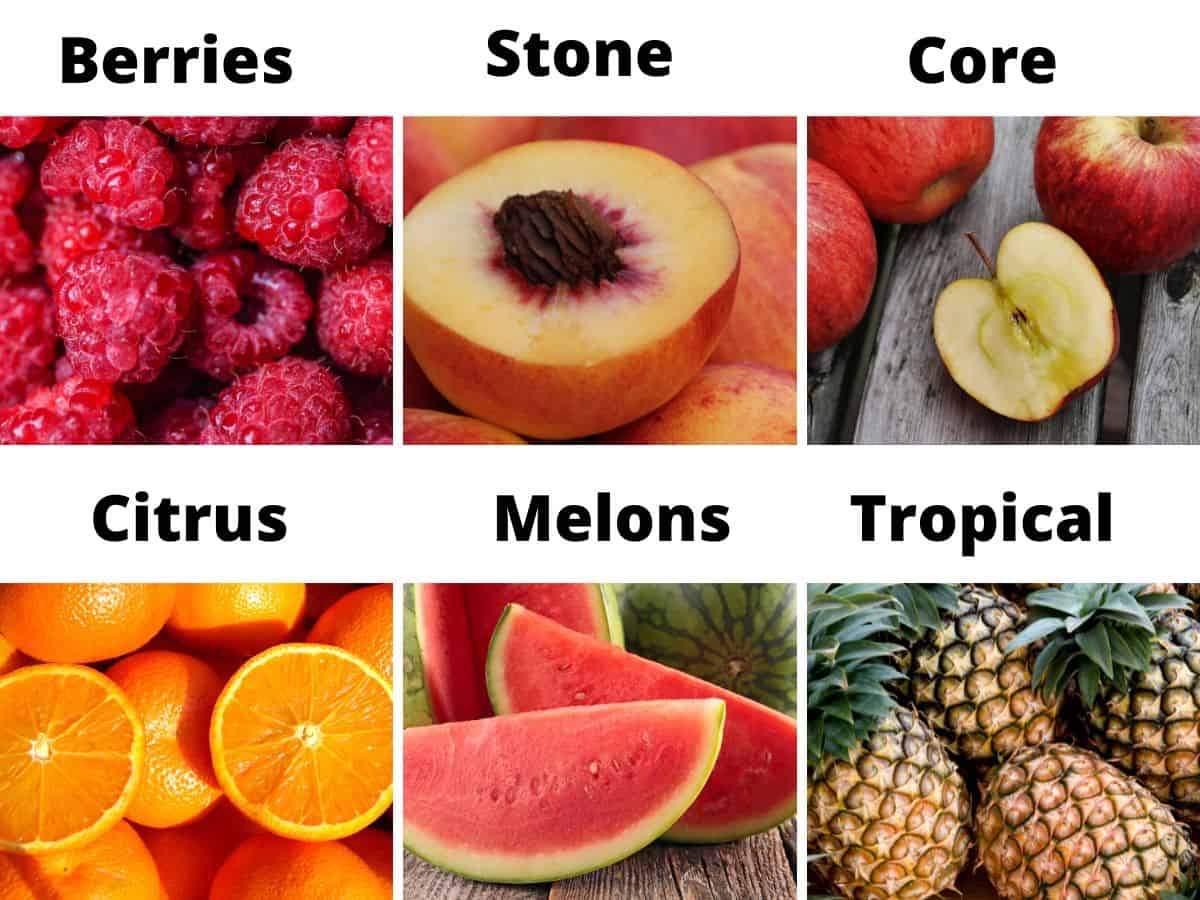
Berries: These small and juicy fruits have tiny seeds. They often grow on bushes or on the ground on vines. Berries include strawberries, blueberries, raspberries, and blackberries, to name a few. Some are sweet, while other berries are tart.
Stone/Pit Fruit: These are large, fleshy, juicy, sweet fruits with a thin outer skin and a pit in the center. Stone fruits include peaches, plums, and nectarines, among others. They grow on fruit trees.
Core Fruit: These fruits have a core at the center where the seeds live. They usually have thin skin and crispy flesh. They grow on fruit trees. Apples and pears are considered core fruits.
Citrus Fruit: Citrus fruits are grown on citrus trees. They have a thick rind and a thick membrane that separates the flesh into sections. They are juicy and range from tart to sweet. Citrus fruits include various types of oranges, grapefruit, lemons, and limes.
Melons: These large and juicy fruits grow on the ground from winding vines. They have thick skins, a juice center, and many seeds throughout the center or as part of the flesh. Melons include watermelons, honeydew melons, and cantaloupe.
Tropical Fruit: Grows in warm and humid climates. Some examples include pineapples, coconut, papaya, mango, and guava.
A List of Fruits That Start With B
- Babaco
- Bacuri
- Bael Fruit
- Balsam Apples
- Banana
- Baobab Fruit
- Barbadine Fruit
- Barbados Cherries
- Barberry
- Batuan Fruit
- Beach Plum
- Bearberry Fruit
- Beechnut
- Betel Nuts
- Bignay Fruit
- Bilberries (Bilberry Fruit)
- Bilimbi Fruit
- Biriba
- Bitter Melon
- Black Apple
- Black Cherry
- Black Mulberry
- Black Raspberry
- Black Sapote
- Blackberries
- Blackcurrants
- Blood Limes
- Blood Oranges
- Blue Tongue Fruit
- Blueberries
- Bolwarra
- Bottle Gourds
- Boysenberry
- Brambles
- Brazil Nut Fruit
- Brazilian Guava
- Breadfruit
- Brush Cherries
- Buffaloberry
- Buddha’s Hand
- Burmese Grapes
- Burdekin Fruit
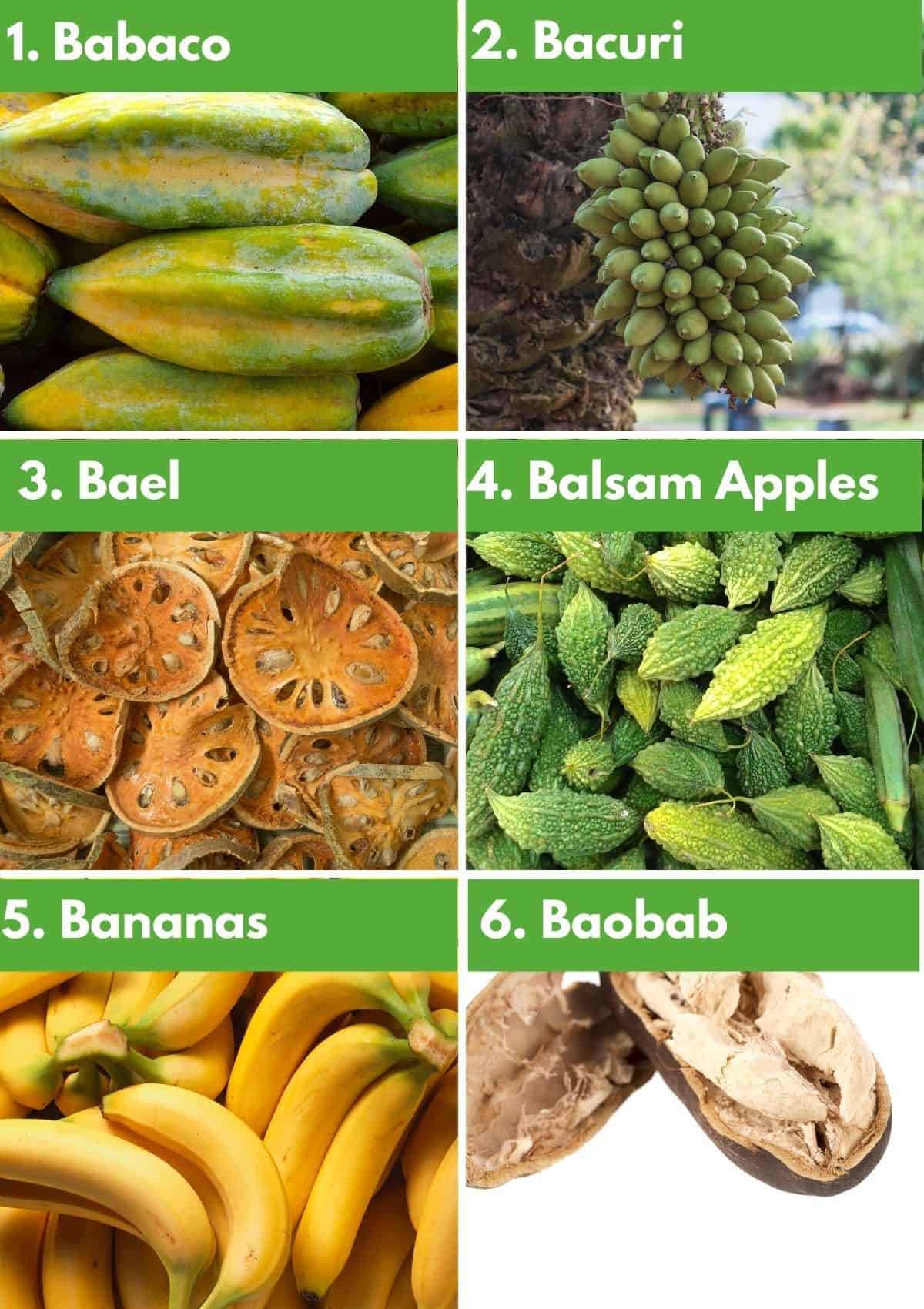
1. Babaco
The babaco fruit is a tropical fruit from Ecuador. It is similar to a papaya but much narrower. It’s seedless and has thin edible skin. Its sweet flavor is somewhere between a strawberry and pineapple combination.
2. Bacuri
This fruit is about the size of an orange and has a sticky pulp with a sweet flavor. It grows on a large tree in Bolivia that reaches as tall as 100 feet. It has a thick peel and seeds that are not edible.
3. Bael
The tropical bael fruit is native to India and Bangladesh. This sweet fruit is used for its Ayurvedic healing properties. It’s eaten both fresh or dried.
4. Balsam Apples
The balsam apple isn’t an apple at all. It is a melon with a pointed end. Interestingly, it is good to eat when green, cooked, and unripened, whereas when it ripens and turns orange, it can cause stomach upset and vomiting. It is grown in Southern Africa.
5. Banana
The famous banana is a tropical fruit with thick yellow skin and a soft white interior. Bananas grow in tropical regions in South and Central America, and areas of India, Africa, and China.
6. Baobab
Baobab is a tropical fruit that grows on trees found in Australia, the Middle East, and some areas of Africa. Ripe baobab has white flesh that tastes like yogurt with a subtle sweetness. The fruit is grown in pods that hang upside down from the tree. The seeds have a chalky texture that is ground into powder and used for its nutritional benefits such as vitamin C, potassium, carbohydrates, and phosphorus.

7. Barbadine Fruit
Barbadine is a tropical fruit member of the passion fruit family that grows in Central and South America. It’s a large fruit with a green skin, when not yet ripe, that turns yellow as it ripens. The fruit’s flesh is soft and creamy, and the inside seed sack is filled with tiny seeds with a yellow coating. It has a sweet floral taste.
8. Barbados Cherries
Barbados cherries are a tropical fruit grown in the Caribbean and South America. They are more tart than traditional cherries, although they are still edible raw. They are often used in jellies and jams to give them the sweetness they need.
9. Barberry
Barberries are grown on bushes around the world, except for Australia. There are many different species of barberry bushes around the world. The small red berries are edible but have a very acidic flavor, making them challenging to enjoy raw. While they are not widely used in cuisine, they are often used in Persian cuisine.
10. Batuan
The batuan fruit is similar in size to tomatoes, with green flesh. It is grown in the Philippines and commonly used in their recipes. The flavor is sour but not acidic. It is used in savory recipes to give it some spice.
11. Beach Plum
Beach plums were once a common tree growing along the Atlantic Coast. However, as homes popped up along the shore, the trees were cut down, resulting in the Beach Plum becoming a rare tree and fruit. The trees produce small plumbs that are similar in color to blueberries and in size to cherries. They are rich in antioxidants and taste great when turned into jam.
12. Bearberry Fruit
The bearberry is a small red berry that looks similar to lingonberry. However, it is tasteless, meaning it isn’t used often as a food but as a medicinal berry and even as a natural dye. It is called bearberry because bears eat it. You can find them in areas of Asia, Europe, and North America. It is a small ground-covering shrub.
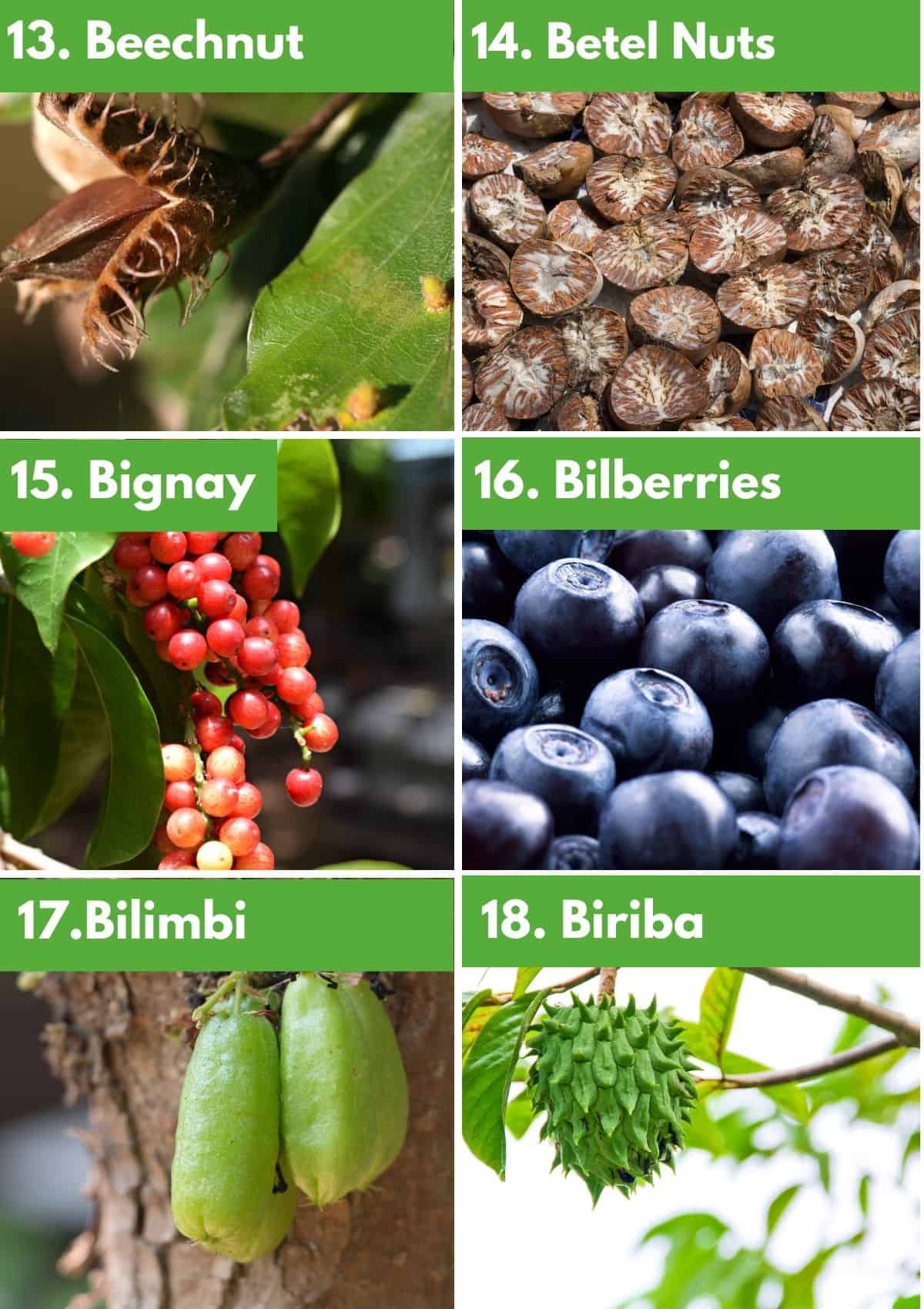
13. Beechnut
The beechnut has a thick shell, and a fruit with a bitter flavor is at the center. It tastes best when roasted and seasoned with savory spices.
14. Betel Nuts
While the betel nut is a fruit, it is not one I recommend consuming or using. It has been described as a combination of a cigarette and a black cup of coffee. People who use it don’t eat it but chew it and spit it out. It’s been linked to mouth and esophageal cancer. It is native to South and Southeast Asia.
15. Bignay Fruit
Bignay fruits are similar to grapes in that they grow on vines. They can be eaten and enjoyed right off the vine. They are native to China, India, Malaysia, Indonesia, the Philippines, and some parts of Australia. It has a tart but sweet flavor when ripe. It is often used to make wine, tea, and jam.
16. Bilberries
Bilberries look similar to blueberries but are grown in Europe. They are rich in antioxidants and are used in recipes similar to blueberries. Eat them raw, or bake them in a pie, quick bread, pancakes, or smoothies.
17. Bilimbi Fruit
The bilimbi fruit is native to Malaysia. It is a tropical fruit that has a unique shape. It is related to the starfruit and grows in clusters. With a similar flavor to cucumbers, it is often pickled and served in savory meals. They are rich in vitamins A, C, and potassium.
18. Biriba
The biriba fruit has a long cone shape and a bright yellow color with spikes that turn brown. The center is white with seeds that look similar to the inside of passionfruit. It grows in Peru and Argentina and is a popular ingredient in Amazon cuisine. It can be eaten fresh and is also often turned into wine.
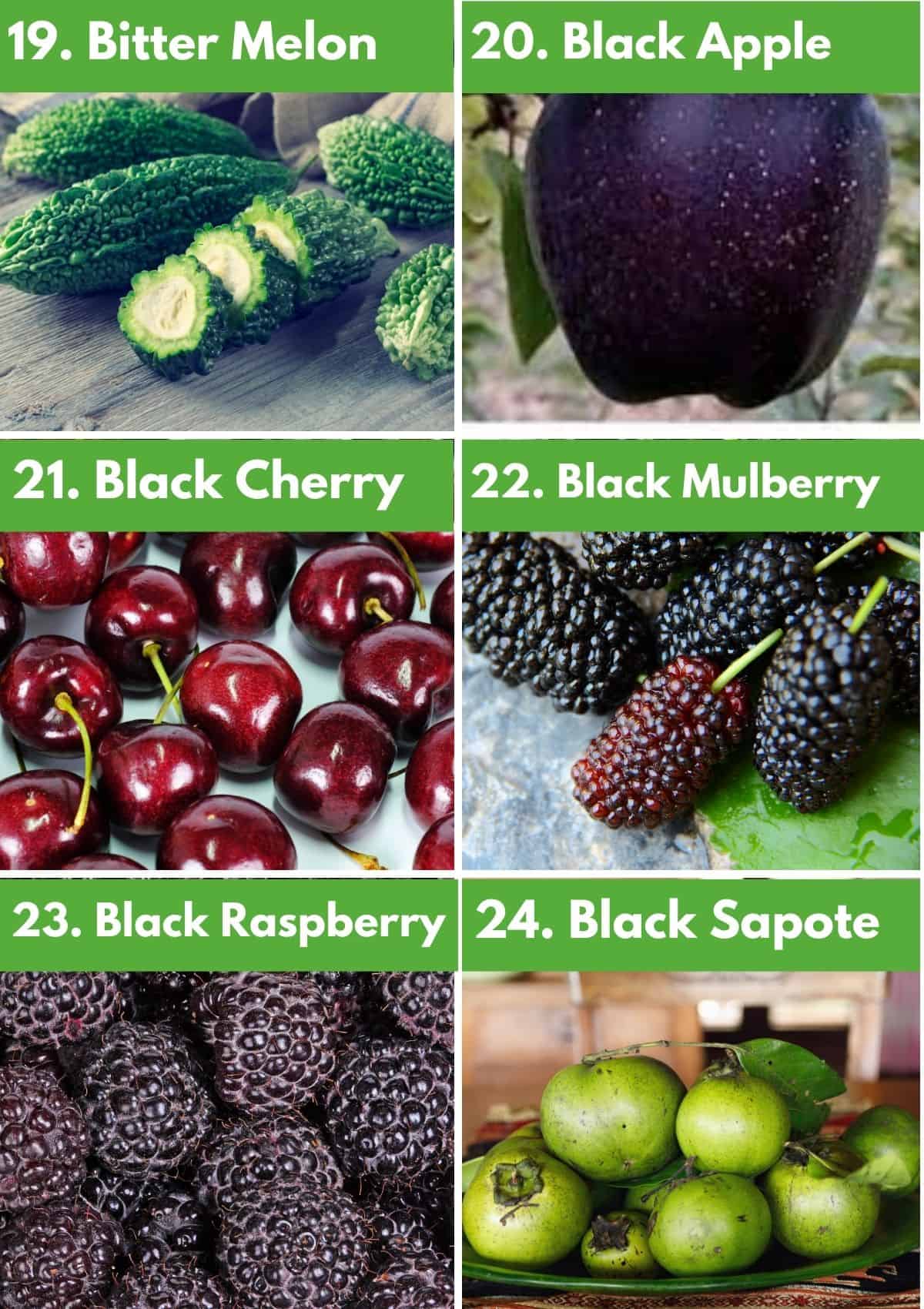
19. Bitter Melon (Bitter Gourd)
The bitter melon is long and green like a cucumber but with a distinct bumpy and rough exterior. Its name is derived from its highly bitter flavor that only becomes more bitter as it ripens. It is native to China and is popular in Chinese cuisine. It is a good source of Vitamin C, Vitamin A, fiber, folate, potassium, and zinc.
20. Black Apple
The black apple is a core fruit that looks like a typical red or green apple but with deep dark purple skin and white flesh. It is grown in the Tibetan region of Nyingch. It has a sweet flavor like other apples and can be used in recipes that call for any apple.
21. Black Cherry
The black cherry is a darker hue than red cherries. It is grown throughout North America in both Canada and the United States. It is popular because it isn’t too sweet or tart, giving them a nice balance of flavor. They taste delicious when baked into pies or jams or eaten fresh.
22. Black Mulberry
The black mulberry looks similar to blackberries but is much larger. They are native to Southwestern Asia and grow on bushes in the wild. They are pretty juicy with a sweet and tart flavor. Black mulberries are used in recipes like blackberries or as a substitute for them when they are unavailable.
23. Black Raspberry
Black raspberries are native to North America. While they look like blackberries, they are a different type of berry characterized by their smaller size and tart flavor. They are delicious to eat, popularly made into jams, and added to pies and other baked goods. These gems are a rich source of vitamin C and fiber. They are in season during July. Outside this time, getting your hands on black raspberries isn’t easy.
24. Black Sapote
The black sapote is related to the persimmon. It grows in Mexico. The inside has a pudding-like texture that is slightly sweet but with a nutty pumpkin flavor. It can be added to smoothies, eaten raw, or baked goods such as quick bread and brownies.
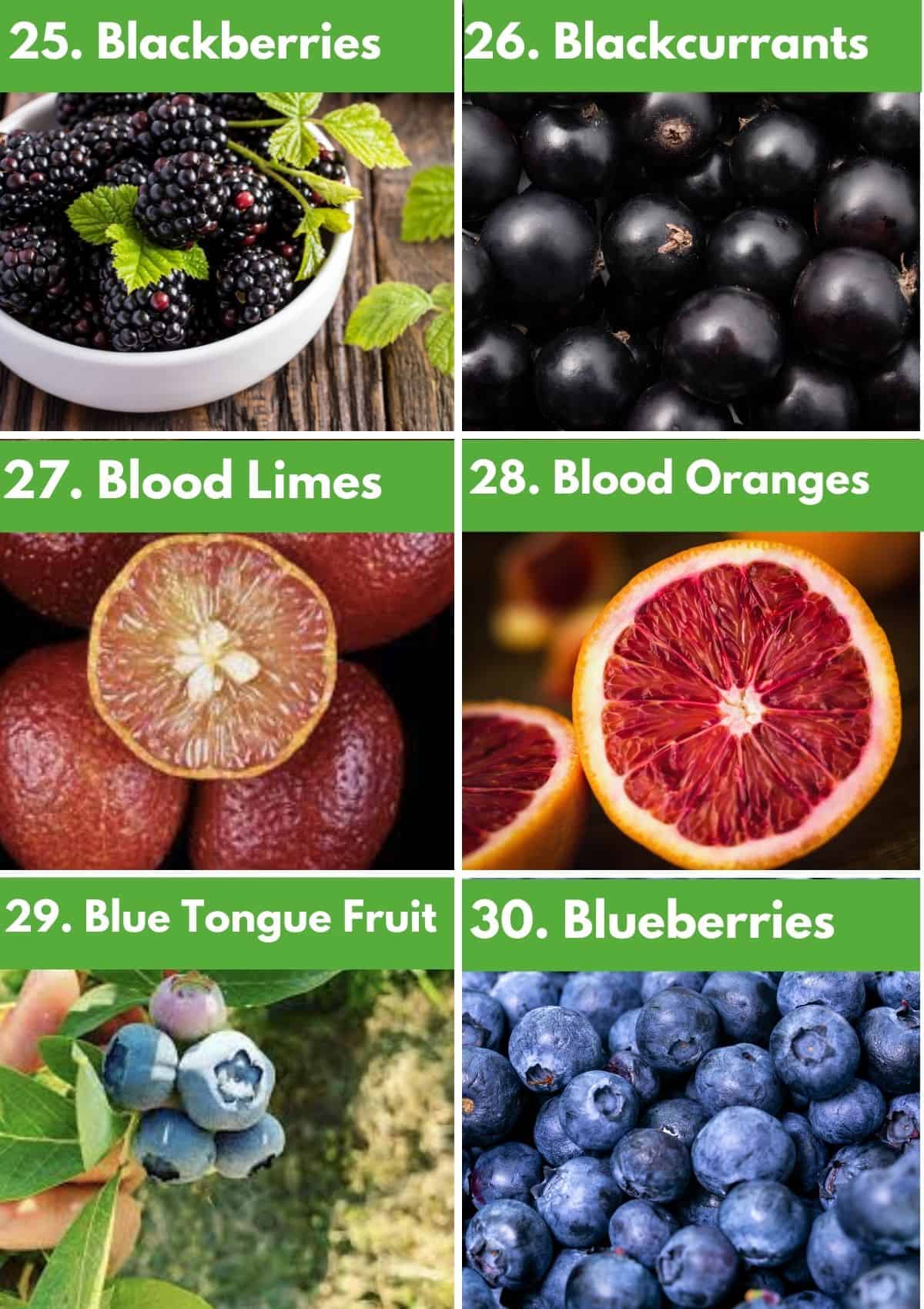
25. Blackberries
Blackberries are large, tart, dark purple berries native to North America and commonly found in grocery stores. They grow on large bushes with thorns and are enjoyed fresh, added to salads, baked into sweets, and made into jam. These berries are an excellent source of vitamins C, K, manganese, and fiber.
26. Blackcurrants
Black currants are native to Europe and North Asia. They have a tart flavor and are full of antioxidants and vitamin C. Homeopathic medicines often use them to help with blood flow, the immune system, eye, gut, and kidney health. It is made into jam, drinks, and baked goods in culinary recipes.
27. Blood Limes
The blood lime is a cross between a lime and a mandarine orange that grows in Australia. It has a deep burgundy peel and red flesh. They can be used in any application you would use a regular lime. Their acidic flavor makes it delicious to add to drinks, as a side to tacos, or to other recipes that need an acidic taste.
28. Blood Oranges
Blood oranges have an orange peel and deep burgundy flesh. The flavor is extra sweet with a hint of raspberry. They are in season from November through May. They can be easily found in grocery stores during this time. Enjoy them fresh, bake them into desserts like this citrus cake, or turn them into an amazing blood orange cocktail.
29. Blue Tongue Fruit
Blue Tongue fruit leaves your tongue blue after eating them, thus the name. The scientific term for this fruit is melastoma. It has a very sweet taste. They grow on an evergreen bush that produces beautiful blue flowers that turn into dark blue fruit with a sweet taste. They grow in warm climates. It’s native to Australia.
30. Blueberries
This common berry grows on shrubs across North America. They are considered superfoods because of their nutritional value. They are rich in antioxidants, vitamins, and minerals and can help manage cholesterol, blood pressure, and blood sugar. Eat them fresh, add them to your cereal, oatmeal, or smoothies, or bake them into your favorite treats!
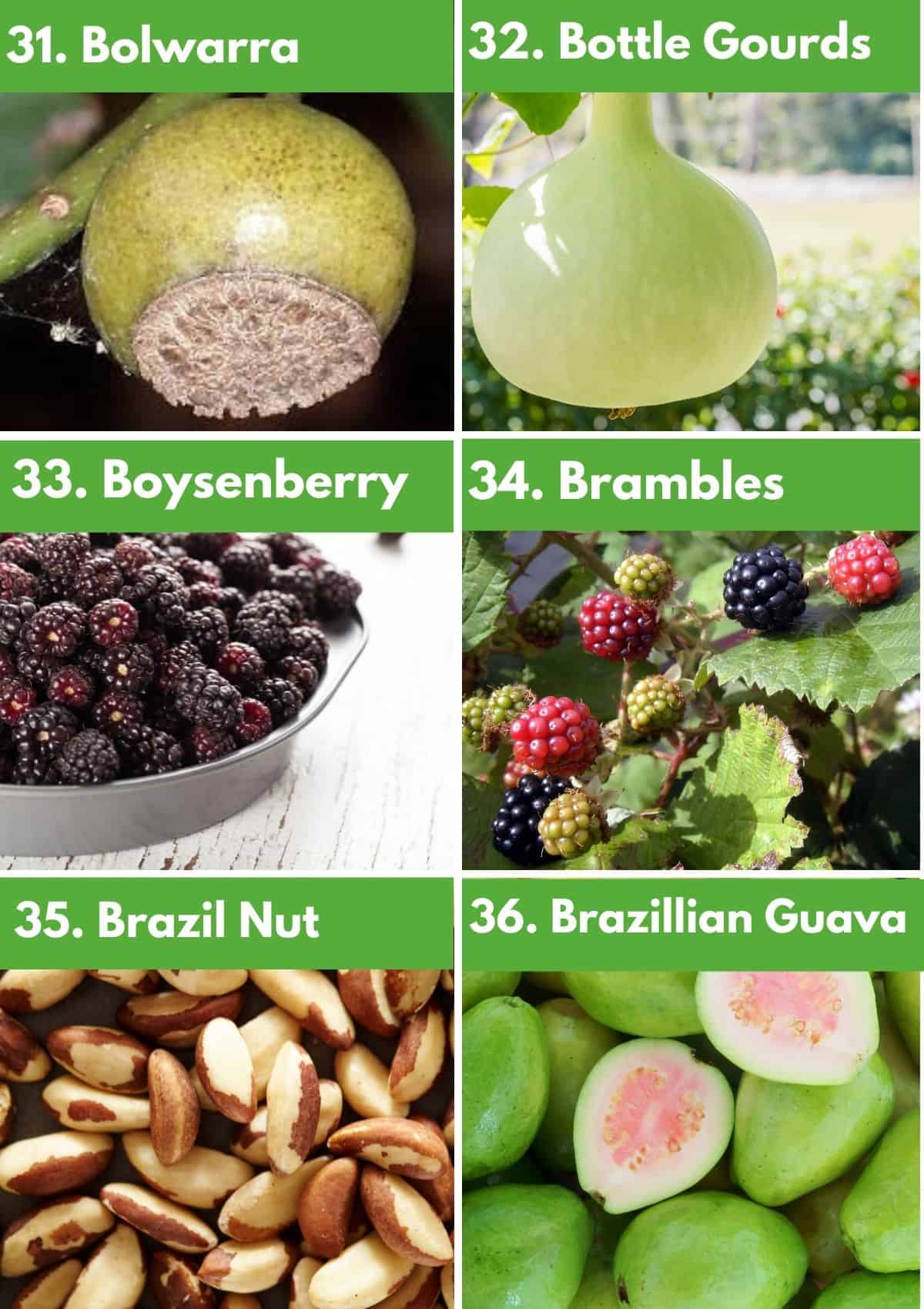
31. Bolwarra
Bolwarra is native to Australia. The fruit has a green outer shell, and the inside resembles a guava. When they ripen, they turn yellow. They are mostly used as a cooking spice or made into jams and desserts.
32. Bottle Gourds
The bottle gourd, also called calabash, is a member of the squash family. It turns yellow when ripe. They have a large round bottom and a long thin neck. It is used in savory recipes such as soups. They have a mild flavor. They are native to Africa and grow in warm climates.
33. Boysenberry
Boysenberries grow in New Zealand and the Pacific Northwest. They are large berries that grow on a vine and taste like a combination of blackberries and raspberries. They are not easy to find fresh in your local grocery store. Your best bet to get fresh boysenberries is at a farmer’s market in one of the regions where they grow. Otherwise, you can find boysenberry jams or syrups.
34. Brambles
Bramble fruit is not a separate fruit but a term for grouping fruits. Brambles are a group of berries, including blackberries, raspberries, boysenberries, and black raspberries. Bramble Fruit creates delicious jams, pies, and other baked goods or berry fruit salad.
35. Brazil Nut
As the name suggests, the Brazil nut is from Brazil, however it is not a nut, but a seed. They are an excellent source of protein, vitamins, minerals, and healthy fat. They can be enjoyed raw or roasted. Consider adding them to your salads for extra protein and nutrients. However, don’t eat too many at one time. They can be poisonous in large amounts due to their selenium content.
36. Brazilian Guava
Like the fruit before, Brazilian Guava gets its name from its country of origin. It is, however, also grown in parts of Peru and Mexico. It has a pear-like shape, thick green skin, and a pink interior resembling a watermelon. The flavor is said to be similar to strawberries. It is used to make a Brazilian dessert called Romeo and Juliet. The guava is mashed and then made into a gelatin-like texture cut into squares and made into a sandwich with cheese in the center.
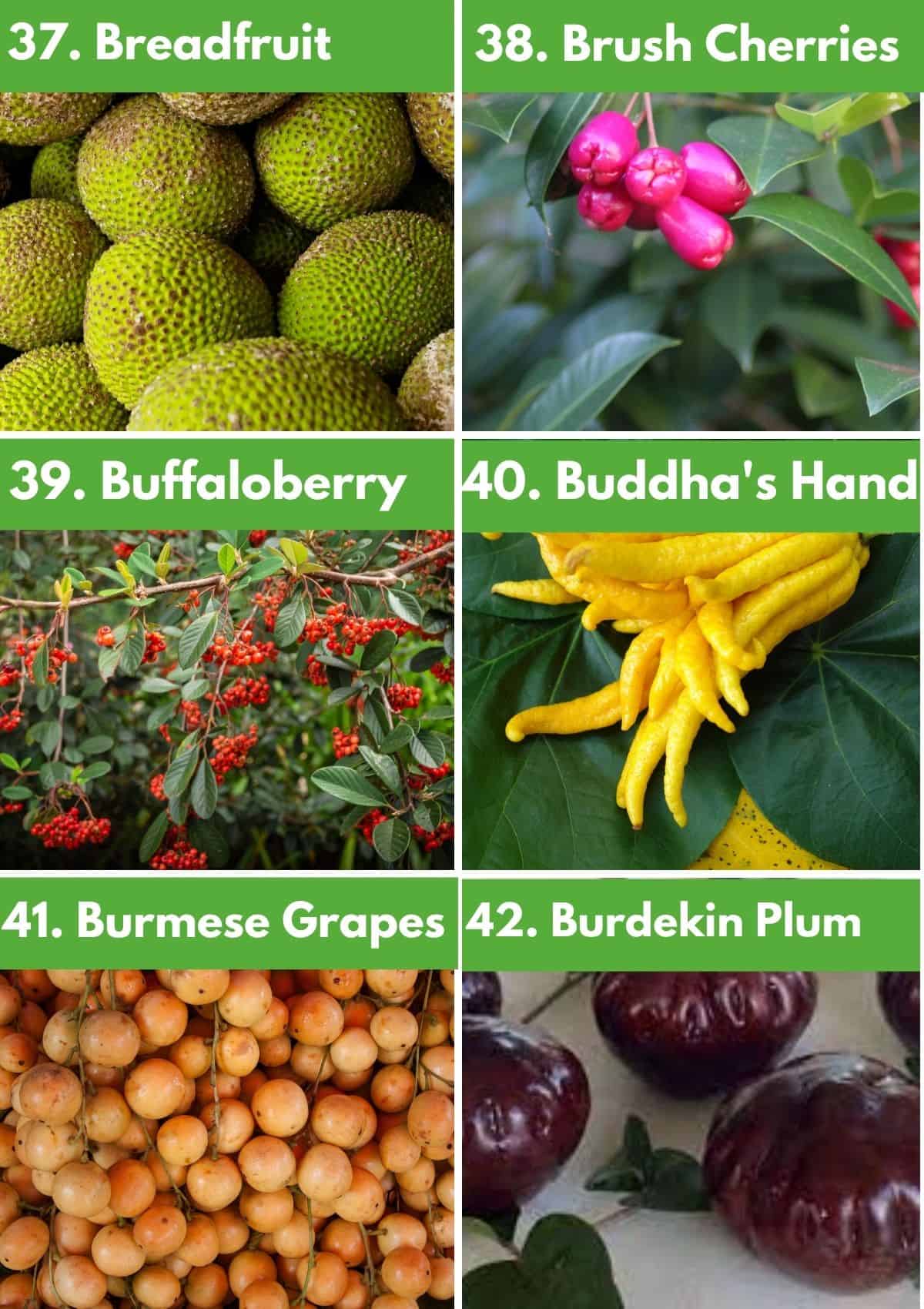
37. Breadfruit
Breadfruit is not the most attractive fruit. It’s grown in Peru and Puerto Rico, and you can find it as an ingredient in recipes from these countries. While its appearance is lacking, its flavor is interesting. It has a savory bread-like flavor, hence the name. It is used in savory recipes like you might use potato. Mash it, bake it, or sauté it.
38. Brush Cherries
Brush cherries are native to New Zealand and Australia. They grow on bushes rather than trees and produce red berries that taste sweet and tart. They can be enjoyed fresh or made into baked desserts such as pies or jams and syrups.
39. Buffaloberry
Buffaloberries are small berries that grow in the Pacific Northwest and Canada. They are bright red but can also be yellow. They grow in forests on thorny shrubs. It has a tart flavor that, while edible, makes them rather unappealing than other berries.
40. Buddha’s Hand
This interesting-looking citrus fruit resembles a hand. Unlike most citrus fruits that are round or oval in shape, buddha’s hand looks like a lemon with long fingers. It does not contain any pulp or juice. However, its rind produces a fragrant lemon odor. It is used in recipes to create a lemon citrus flavor, such as dressings, marinades, or baked goods. They are native to Northeast India and China.
41. Burmese Grapes
Burmese grapes grow on evergreen trees found in parts of Asia. To eat them, remove the outer peel. Inside, you’ll find segments that can be spit apart. It has a fibrous texture and a sweet and sour flavor.
42. Burdekin Plum
The Burdekin plum resembles a purple plum. It is deep purple with a rounded shape. The flesh is mildly sweet with a hint of tart flavor. They grow on trees but ripen after they are picked. This plum is native to Australia and used in savory recipes as a sauce alongside meat or made into jams or wine. It is rich in vitamin C, fiber, and antioxidants.
Final Thoughts
There are so many different fruits that start with B. Some are more common than others. I hope this list has introduced you to some new fruits you may want to try or use in recipes. Suppose I missed a fruit. Comment below. I will update this list as I discover new and exciting fruits!
More Fruits A to Z!
Please comment below if you found this article helpful or have any additional questions. You can also follow me on Instagram, Pinterest, and Facebook for more family-friendly vegan recipes!


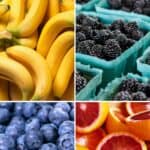
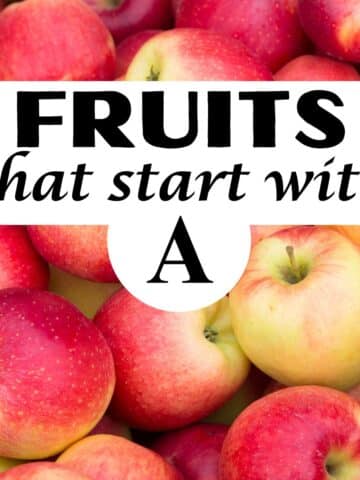
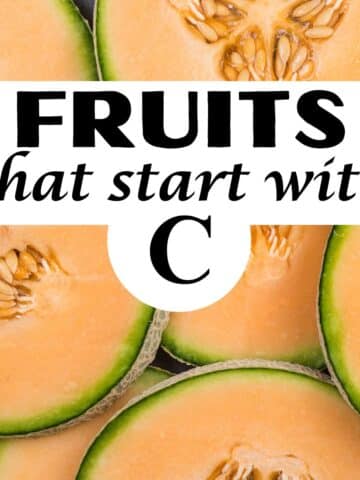
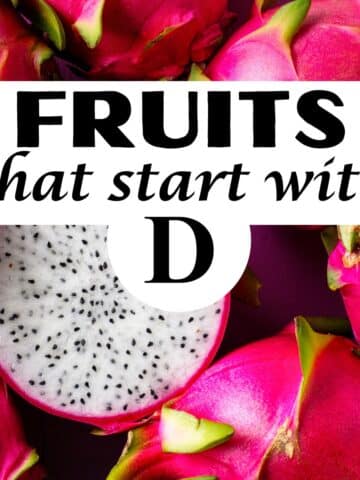
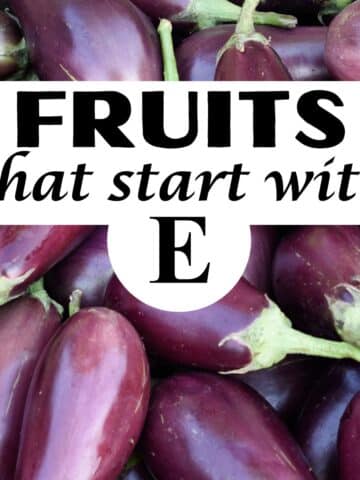
Leave a Reply